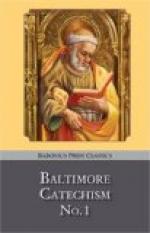Again, it is much easier to change one thing into another than to make it entirely out of nothing. Anyone who can create out of nothing can surely change one thing into another. Now Our Lord, being God, created the world out of nothing; and He could therefore easily change the substance of bread into the substance of flesh. I have said Our Lord’s body in the Holy Eucharist is a living body, and every living body contains blood; and that is why we receive both the body and the blood of Our Lord under the appearance of the bread alone. The priest receives the body and blood of Our Lord under the appearance of both bread and wine, while the people receive it only under the appearance of bread. The early Christians used to receive it as the priest does—under the appearance of bread and under the appearance of wine; but the Church had to make a change on account of circumstances. First, all the people had to drink from the same chalice or cup, and some would not like that, and show disrespect for the Blessed Sacrament by refusing it. Then there was great danger of spilling the precious blood, passing it from one to another; and finally, some said that Christ’s blood was not in His body under the appearance of bread. This was false; and to show that it was false, and for the other reasons, the Church after that gave Holy Communion to the people under the appearance of bread alone. The Church always believes and teaches the same truths. It always believed that the Holy Eucharist under the appearance of bread contained also Our Lord’s blood; but it taught it more clearly when it was denied.
243 Q. Is Jesus Christ whole and entire both under the form of bread and under the form of wine? A. Jesus Christ is whole and entire both under the form of bread and under the form of wine.
244 Q. Did anything remain of the bread and wine after their substance had been changed into the substance of the body and blood of Our Lord? A. After the substance of the bread and wine had been changed into the substance of the body and blood of Our Lord there remained only the appearances of bread and wine.




